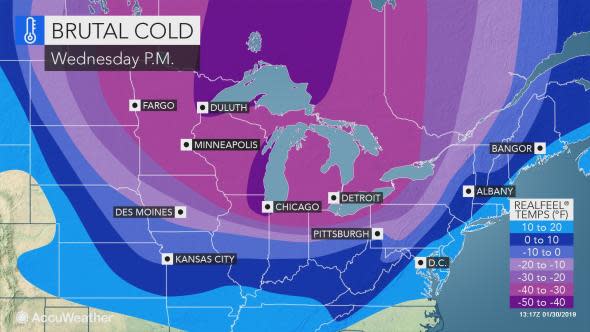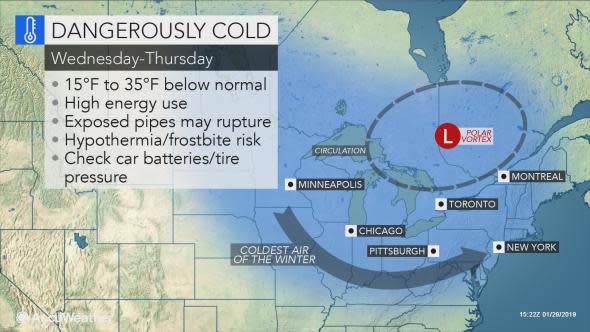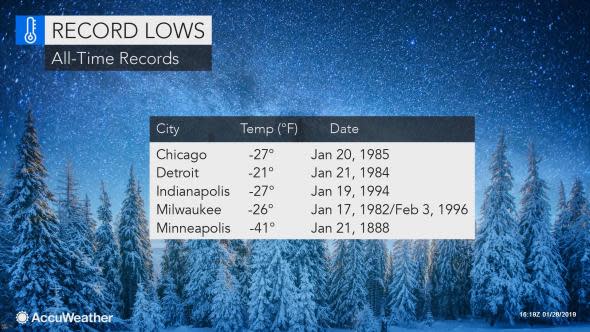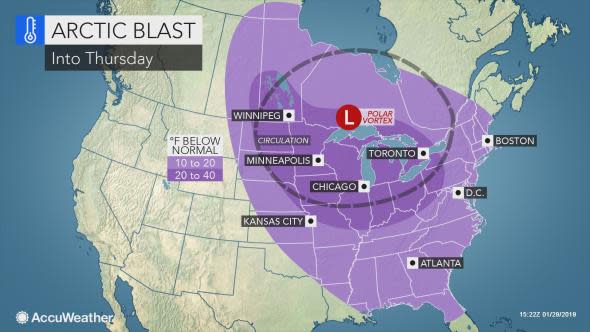As polar vortex tightens its grip on midwestern US, AccuWeather RealFeel® Temperatures plummet to -75 F
See the latest on the polar vortex invasion.
The coldest weather in years will put millions of people and animals throughout the midwestern United States at risk for hypothermia and frostbite to occur in minutes during the final days of January.
The deep freeze has a firm grip on the Upper Midwest with an AccuWeather RealFeel® Temperature of 75 degrees below zero Fahrenheit reported at Grand Forks, North Dakota, on Tuesday morning.
Wednesday is turning out to be the harshest day of this week in the Midwest as the polar vortex gets displaced from the Arctic Circle and dives into the region.
In addition to the risks of frostbite and hypothermia, residents will be faced with high heating costs and the potential for frozen and bursting water pipes, dead car batteries and school closures.

The cold can be life-threatening for any person or animal without a proper way to stay warm.
One man was found frozen to death in a garage in Milwaukee, Wisconsin, according to the Associated Press.
While the Arctic blast plunged into the Midwest following the departure of the early-week snowstorm, the most extreme conditions are occurring at midweek.
"Some locations in the Midwest will be below zero continuously for 48-72 hours," according to AccuWeather Senior Meteorologist Mike Doll.
The harshest conditions are anticipated from North Dakota to northern Illinois, where there can be a prolonged stretch of dangerously low AccuWeather RealFeel® Temperatures that can cause frostbite in mere minutes.
On Wednesday, highs will stop well short of rising above 10 below zero from Fargo, North Dakota, to Minneapolis and Chicago. Highs in the single digits will have those from Kansas City, Missouri, to St. Louis to Cincinnati, Ohio, and Pittsburgh shivering.
Wednesday night can be just as cold, if not colder, than Tuesday night in many areas.
Temperatures in Chicago dropped under 22 below zero for the first time since the mid-1980s on Wednesday morning, shattering the day's record low of 15 below zero from 1966.

As biting winds usher in the Arctic blast, AccuWeather RealFeel® Temperatures may barely rise to near 30 below zero during Wednesday afternoon.
RealFeel® Temperatures will be under 40 below zero in Chicago most of the time into Thursday morning.
"I cannot stress how dangerously cold it will be," Doll stated. "An entire generation has gone by without experiencing this type of cold in the Chicago area."
SEE ALSO:
The last time Atlanta hosted the Super Bowl, a major ice storm wreaked havoc
Antarctica's ice loss has sextupled since the 1970s, raising risk of sea level rise
Photos: Pre-polar vortex snowstorm slows travel from Minneapolis to Chicago, Detroit
How record-setting cold contributed to the space shuttle Challenger disaster on Jan. 28, 1986
The cold can shatter records both during the day and at night as temperatures are held 20 to 40 degrees below normal.
Minneapolis is expected to break at least one record low during this Arctic outbreak. A record low has not been recorded at the city's airport during the month of January since Jan. 11, 1977.
The last subzero high in Chicago was on Jan. 6, 2014, when the temperature reached only 2 below zero.
Jan. 13 to Jan. 15, 2009, was the last period of three consecutive days with subzero high temperatures in Minneapolis.

Precautions are being taken in several states because of the cold.
Governors have declared a state of emergency in Wisconsin, Michigan and Illinois due to the dangerous cold. Minneapolis Public Schools and the University of Wisconsin--Madison are among the schools and universities to cancel classes.
Download the free AccuWeather app to see just how cold it will get in your area.
Residents will once again have to take the proper precautions and cover all exposed skin to avoid frostbite and hypothermia.
Warming centers and shelters have been opened or are expanding hours and capacity in many cities to provide a safe place for the homeless. Warming buses are also being offered in Chicago, according to the Associated Press.
Be sure that livestock have sufficient means to stay warm, and limit time that pets spend outside.

Residents should ensure that they have a proper amount of propane, wood pellets and/or firewood to last during this cold outbreak. A life-threatening situation can arise in homes that lose heat.
Motorists should travel with a winter survival kit in the event their vehicle breaks down and are then forced to wait for help.
Air travel is also being affected due to the cold.
Due to the extreme cold, airlines at Midway have cancelled 270+ flights and are reporting delays of less than 15 min. Check flight status with carrier.
— Midway Intl. Airport (@fly2midway) January 29, 2019
Amid the cold, a prolonged, lake-effect snow event can create other travel hazards downwind of the Great Lakes. More ice jams can form along area rivers, raising the risk of flooding in nearby communities.
While the harshest conditions are anticipated across the Midwest, the Arctic blast will spread into the Northeast to end January.
The life-threatening cold is expected to ease in the Midwest on Friday before a turn to dramatically warmer weather this weekend.
There can be a swing of 40 to 70 degrees Fahrenheit from the lowest temperature reading endured during the Arctic outbreak to highs when the warmth takes hold.
Winter storms create a unique set of challenges in the Northeast compared to other areas of the country. Great minds often come together to face the challenge. AccuWeather Meteorologist Dave Dombek joins WABC New York's Chief Meteorologist, Lee Goldberg to talk about their years of collaboration taking on the big storms.

